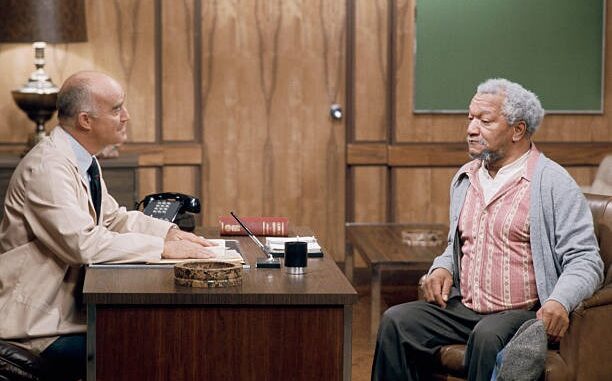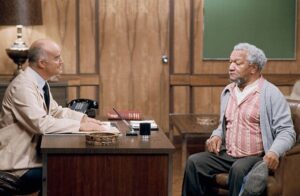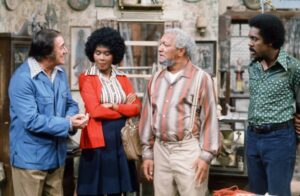
The key to success for all of his shows, Lear explains in his book, was to use real stories from the lives of his writers to build characters the audience would bond with. “The audiences themselves taught me that you can get some wonderful laughs on the surface with funny performers and good jokes,” he writes. “But if you want them laughing from the belly, you stand a better chance if you can get them caring first.”
At its debut, Sanford and Son was the first network show with a predominantly Black cast since Amos ‘n’ Andy in 1951. The setup followed the framework set by All in the Family: Fred Sanford was the irascible elder, often espousing bigoted or insensitive views and annoyed by the more openminded, progressive attitude of his son Lamont.
Foxx and Wilson were surrounded by a murderer’s row of performers in supporting roles. Besides Mayo as Fred’s pal Grady, there were LaWanda Page as Fred’s Bible-toting sister-in-law Esther Anderson, Lynn Hamilton as Fred’s beautiful and kind-hearted girlfriend Donna Harris, Gregory Sierra as the Sanfords’ Puerto Rican neighbor Julio Fuentes and future Karate Kid star Pat Morita as Lamont’s Asian-American friend Ah Chew (yeah, it was the ’70s).

Storylines often revolved around Fred’s get-rich-quick schemes and Lamont’s frustration with his father’s unwillingness to do half the work of running their business. Fred often called his son “dummy,” and he sought sympathy during arguments or tense times by faking a heart attack — grabbing his chest and declaring, “This is the big one, Elizabeth! I’m comin’ to join you!”
Back in those days, sitcom characters often had catchphrases fans could connect with and anticipate. So, in addition to his pseudo heart attacks, Fred would often get frustrated and threaten to punch someone, holding up his fist and asking, “How’d you like one of these across your lips?” Or he’d announce with pride that his name was “Fred G. Sanford,” adding that the G stood for various words that would be funny in the moment, like genius or grandpa.
Inspiration for such flourishes often came from his own life. Redd Foxx was born John Elroy Sanford, and his father and brother were both named Fred. Foxx said his mother, Mary, often exaggerated her illnesses to get her kids to fall in line.
Besides his conflicts with Lamont, Fred locked horns with his late wife’s sisters, especially Aunt Esther. Page played Esther as an upstanding church lady who viewed Fred with skepticism and disdain, seeing through his many schemes and wary of how he might mislead Lamont. Several of the show’s highlights involved Fred and Esther trading insults, with him comparing her to King Kong and her calling him “you old heathen” while beating him with her purse.
And in exchanges that might make modern audiences squirm, Fred expressed prejudices against Latinx and Asian people. He would intentionally mispronounce Ah Chew (the name itself already sounded like a disrespectful joke), and he had serious concerns when his younger sister married a white man.
Fred even used the n-word during an episode. The moment came during a courtroom scene; Lamont was contesting a speeding ticket, and Fred stood up to declare that he was representing his son. Taking in the crowd of Black people gathered for their own tickets, Fred declares, “There’s enough n—–s in here to make a Tarzan movie!”
Bud Yorkin told NPR back in 2008 that Foxx pushed him to allow use of the word in that scene. “He said, ‘Let me do that stuff. I want to be able to say that,'” Yorkin recalled in an interview for the radio network’s In Character series. “And I said, ‘Well, you know, I don’t feel comfortable with it.’ …He said, ‘I can do it — you can’t do it. I don’t want somebody else doing it, but I can do it.’ So I said, ‘Well, okay, Redd,’ and he did it. And, by and large, we never got any complaints.”
Bergman says that episode convinced him that Sanford and Son was covering material far different from any other sitcom on the air. “That was so groundbreaking at a time when you had [escapist] stuff like Beverly Hillbillies and Petticoat Junction,” he says. “[Sanford and Son] started a trend toward more realism in television. Things were being talked about that were not being talked about before.”
But Sanford and Son also had its critics, who saw long-held stereotypes about lazy Black men in Fred’s allergy to work, praise for the cheap wine
Ripple and get-rich-quick schemes.
In a 1973 story for the New York Times, Black writer Eugenia Collier called the show “white to the core,” alleging that the series presented a vision of Black men through the eyes of white people that was limiting and damaging. “We — all of us — need to be surrounded by positive — and true — images of Blackness,” she wrote, “based upon Black realities, not upon white aberrations.”
While Sanford and Son was part of the trend toward realism in sitcoms, it reflected other, more specific, trends as well. It was the first in an array of mid-’70s comedies focused on people of color in working-class neighborhoods, including Good Times, which Norman Lear spun off from Maude; Chico and the Man, the NBC series starring Freddie Prinze; and What’s Happening!!, which was loosely based on the Black-centered coming-of-age film Cooley High. Add in That’s My Mama and Lear’s legendary The Jeffersons, and you had another trend: comedies centered on non-white (usually Black) stars and casts.

The advantages of such shows were obvious. Black performers, long relegated to supporting roles in comedies like All in the Family and Maude, now had showcases focused on their own fictional family groups.
Talented non-white stars like Foxx, Prinze, John Amos and Esther Rolle of Good Times and Sherman Hemsley on The Jeffersons were introduced to national (white) audiences. And unlike the bad old days of Amos ‘n’ Andy, their characters acknowledged the racism and poverty experienced by Black people.
Still, these were shows controlled and often written by white men. They could reinforce stereotypes with clunky jokes and storylines rooted in backwards ideas. And they could make life in deprived neighborhoods look funny and tolerable, glossing over the dangers found in housing projects or economically depressed areas.
Foxx himself was an unlikely TV star. Born in St. Louis, he worked his way up the show biz ladder as a nightclub comic, earning fame with a raunchy act that worked well on comedy party albums and in Black clubs. By the late 1960s, he was playing Las Vegas and appearing on assorted TV shows; his role as a junkman in the 1970 action-comedy film Cotton Comes to Harlem presaged his work on Sanford and Son, which turned him into an overnight success after more than thirty years in the industry.
“Audiences just loved him,” Bergman says of Foxx. “It was because he was saying stuff that just wasn’t heard on television before.”
Sanford and Son was an almost instant hit, landing in the Nielsen top ten for nearly all of its six seasons on the air. Across that run it earned seven Emmy nominations, including two for outstanding comedy series and two for Foxx as outstanding lead actor in a comedy. Still, Foxx had his ups and downs with the show, walking off briefly in season three during a salary dispute, and walking away altogether after the sixth season to host a variety show on rival network ABC.
Efforts were made to continue or revive the idea in series such as Sanford Arms and Grady, and in a show that Foxx tried without Wilson as Lamont, called Sanford. Foxx died in 1991 after experiencing a heart attack on the set of a CBS sitcom, The Royal Family.
But Sanford and Son stands as a tribute to Foxx’s talent and persistence — a pioneering show with a legendary character that paved the way for so many Black performers and characters to come.
